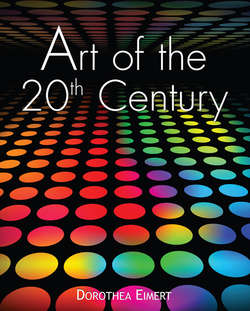Читать книгу Art of the 20th Century - Dorothea Eimert - Страница 10
На сайте Литреса книга снята с продажи.
Abstractions
De Stijl: The Uniformity of the Painting Surface
ОглавлениеDe Stijl, the Dutch counterpart to Russian Constructivism, was also oriented towards the universal and infinite. However, it was based on the theory of the Dutch theosopher, van Schoenmaeker, concerning the mathematical structure of the universe and did not have any technological visions, as did Constructivism. De Stijl, as did Russian Constructivism, entered into a dialogue with the universe, but not with technological visions as did the Russians. Rather, it did this with a philosophical-anthroposophical orientation. There are:
Two basic opposing forces that have created our earth and all earthly shapes. They are the earth’s horizontal line of energy around the sun and the vertical movement of the earth rays having their origins in the centre of the sun.
Schoemaeker’s teachings became the basis of the art and aesthetics of De Stijl, of which the leading mind was Piet Mondrian. He became acquainted with Synthetic Cubism in Paris and was extremely impressed with the logic of its principles. A short time later in 1913, Mondrian sketched paintings that consisted mostly of horizontal and vertical lines. Apollinaire coined the name Abstract Cubism for this, and this was the basis for De Stijl.
During World War I, Mondrian returned home and found like-minded people there: the painter Bart van der Leck, Theo van Doesburg, Vilmos Huszár from Hungary, the Belgian painter and sculptor Georges Vantongerloo, the architects J. J. P. Oud, R. van’t Hoff and Jan Wils, as well as the poet Antonie Kok. They founded the artist group, De Stijl and, at the same time in 1917, published the first issue of their magazine by the same name that ran until 1931. Later in 1925, César Domela and Friedrich Vordemberge-Gildewart joined the group. The most significant architect of the movement was Gerit Thomas Rietveld, who revolutionised architecture and design under the De Stijl banner. The first De Stijl manifesto appeared in November 1918:
‘There is an old and a new time consciousness. The old one is centred on the individual; the new one is centred on the universal.’ Van Doesburg explained in 1923: Our ‘art is neither proletarian nor bourgeois; moreover it is gathering forces that as far as it is concerned influence the entire cultural spectrum.’
Mondrian limited the forms used in his paintings to simple geometric shapes like the straight line and the rectangle. Using the primary colours blue, yellow and red together with the ‘non-colours’ black, white and gray, he divided the painting surface in an uneven system of grids. With these limited formal means he wanted to create an asymmetrical equilibrium that did away with the traditional rigid and static symmetric system. The Neue Bauen (New Building) of the 1920s used these ideas, as did typography and commercial art. Some of the new ideas of De Stijl were implemented by Bauhaus. The De Stijl group broke apart in 1925. Theo van Doesburg immediately thereafter in Paris founded the Abstaction-Création group that became a refuge for more many emigrants from Germany and Eastern Europe.
Piet Mondrian was fascinated by Cubism, primarily by the drawings, when he saw it in 1911 for the first time in Paris. The black lines that were the basic element of Cubism overwhelmed Mondrian, and by 1912, he put it over the painting surface like a grille. This had the effect of the lead rods of a church window. The famous series Trees was created. He painted the tree again and again in progressively more abstract fashion until he had arrived at a concise form that was a sort of symbol for a tree. His studies led him in 1915 to paintings that consisted only of a pattern of vertical and horizontal lines. The amazing new thing about this was the even distribution of the symbols on the painting surface. A recognisable centre had disappeared. Now, he could draw an abstract net across the canvas, and, if he wanted, out of this series of lines, he could have the familiar resurface. The uniformity in a painting had been discovered; its complete autonomy. He sought its static strength. He found the solution for the first time in 1918 with a pure screen painting.
At the beginning of the 1920s, he composed a series of masterworks. With their large red, blue, or yellow surfaces, they radiate a suggestive power of a rising, an expansion, and of dynamism in a black lattice net. Besides these, he composed works in whose centre there is a white emptiness and thereby achieves a suggestive radiating power. In the late 1930s, the all-encompassing screen paintings became prominent once again and with them the experiments with controlled coincidence. In New York, he found another item to help him with his sketches. This was adhesive tape. With this new helpful item, it became possible for him to work more quickly and to execute the random distribution of the directed shifts and regroupings more quickly. He could now avoid corrective and time-consuming repainting.
Max Bill, Infinite Torsion (Curva infinita), 1953–1956. Bronze, 125 × 125 × 80 cm.
Openluchtmuseum voor Beeldhouwkunst Middelheim, Antwerp.
